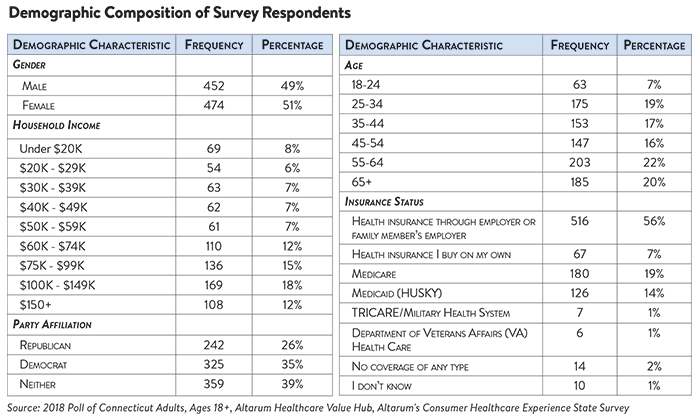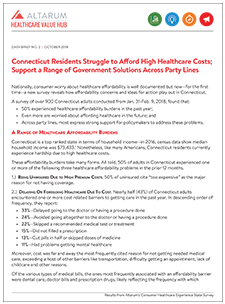Connecticut Residents Struggle to Afford High Healthcare Costs; Support a Range of Government Solutions Across Party Lines
Nationally, consumer worry about healthcare affordability is well documented but now—for the first time—a new survey reveals how affordability concerns and ideas for action play out in Connecticut.
A survey of more than 900 Connecticut adults conducted from Jan. 31-Feb. 9, 2018, found that:
- 50% experienced healthcare affordability burdens in the past year;
- Even more are worried about affording healthcare in the future; and
- Across party lines, most express strong support for policymakers to address these problems.
A Range of Healthcare Affordability Burdens
Connecticut is a top ranked state in terms of household income—in 2016, census data show median household income was $73,433.1 Nonetheless, like many Americans, Connecticut residents currently experience hardship due to high healthcare costs.
These affordability burdens take many forms. All told, 50% of adults in Connecticut experienced one or more of the following three healthcare affordability problems in the prior 12 months.
1.) Being Uninsured Due to High Premium Costs. 50% of uninsured cite “too expensive” as the major reason for not having coverage.
2.) Delaying Or Foregoing Healthcare Due To Cost. Nearly half (43%) of Connecticut adults encountered one or more cost related barriers to getting care in the past year. In descending order of frequency, they report:
- 33%—Delayed going to the doctor or having a procedure done
- 24%—Avoided going altogether to the doctor or having a procedure done
- 22%—Skipped a recommended medical test or treatment
- 15%—Did not filled a prescription
- 13%—Cut pills in half or skipped doses of medicine
- 11%—Had problems getting mental healthcare
Moreover, cost was far and away the most frequently cited reason for not getting needed medical care, exceeding a host of other barriers like transportation, difficulty getting an appointment, lack of childcare and other reasons.
Of the various types of medical bills, the ones most frequently associated with an affordability barrier were dental care, doctor bills and prescription drugs, likely reflecting the frequency with which Connecticut adults seek these services—or, in the case of dental, lower rates of coverage for these services.
3.) Struggling To Pay Medical Bills. Fully one quarter (24%) of Connecticut adults experienced one or more of these struggles to pay their medical bills:
- 10%—Contacted by a collection agency
- 9%—Used up all or most of their savings
- 7%—Racked up large amounts of credit card debt
- 6%—Placed on a long term payment plan
- 6%—Were unable to pay for basic necessities like food, heat, or housing
- 4%—Borrowed money or got a loan or another mortgage on their home
High Levels of Worry About Affording Healthcare in the Future
Connecticut adults also exhibit high levels of worry about affording healthcare in the future.
Overall, four out of five residents (79%) report being “worried” or “very worried” about affording some aspect of healthcare, including:2
- 66%—Won’t be able to afford medical costs when you are elderly
- 61%—Cost of a serious illness or accident
- 52%—Prescription drug costs
In addition, respondents are also “worried” or “very worried” about not being able to afford health insurance in the future (62% overall). The greatest worry is among those who buy coverage on their own—more than four out of five (82%) are worried (Figure 1). Those on Medicaid also have significant affordability concerns, but have the highest level of worry about losing coverage when compared with those with other types of coverage.
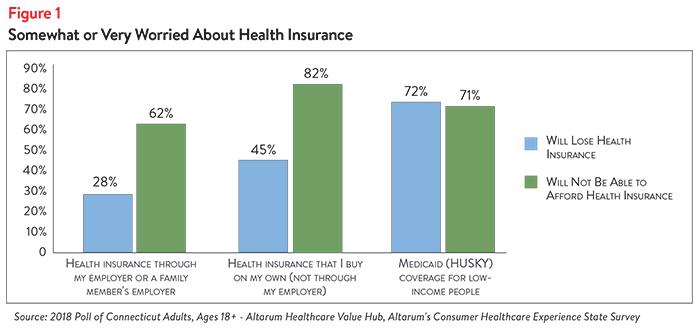
Income Differences in Healthcare Affordability Burdens
The survey also revealed income differences in how Connecticut residents experience healthcare affordability burdens. Responses were mapped into three income brackets (Figure 2).
Affordability burdens affect families quite far up the income stream, with more than 50% of residents with household incomes of $75,000 or below facing healthcare affordability burdens. As a reminder, median household income in Connecticut was $73,433 in 2016.3
In addition to affordability burdens experienced in last 12 months, residents in the lowest income bracket report the highest levels of worry about the future, however, high income residents are still concerned about affording healthcare costs in the future (Table 1).
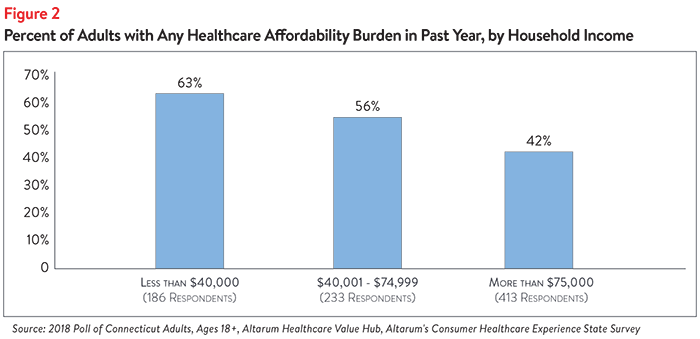
Dissatisfaction with the Health System and Support for Change
In light of these healthcare affordability concerns, it is not surprising that Connecticut residents are extremely dissatisfied with the health system. Statewide:
- Just 18% agree or strongly agree with the statement “We have a great healthcare system in the U.S.,”
- while 80% agree or strongly agree “the system needs to change.”
Of more than 20 options, the options cited most frequently as being a “major reason” for high healthcare costs were:
- 81%—Drug companies charging too much money
- 74%—Hospitals charging too much money
- 74%—Insurance companies charging too much money
- 60%—Some well-known or large hospitals or doctor groups using their influence to get higher payments from insurance companies
When it comes to tackling costs, respondents either agreed or strongly agreed to a number of strategies:
- 95%—Show what a fair price would be for specific procedures
- 94%—Require insurers to provide upfront cost estimates to consumers
- 94%—Authorize the Attorney General to take legal action to prevent price gouging or unfair prescription drug price hikes
- 94%—Make it easy to switch insurers if a health plan drops your doctor
- 93%—Require drug companies to provide advanced notice of price increases and information to justify those increases
- 92%—Require hospitals and doctors to provide up front patient cost estimates
- 91%—Prohibit drug companies from charging more in U.S. than abroad
- 89%—Set standard prices for drugs to make them affordable
- 89%—Set standard payment to hospitals for specific procedures
- 65%—Make medical school free or cheaper to deal with doctor shortages
- 54%—Pay doctors and hospitals a fixed monthly fee per patient, instead of payment for each service
What is remarkable about the findings is high support for change regardless of the respondent’s political affiliation (Table 2).
While Connecticut residents are united in calling for a role for government in addressing high healthcare costs, they also see a role for themselves:
- 83%—Would switch from a brand to a generic if given the option
- 67%—Have tried to find out the cost of a drug beforehand
- 56%—Reported that taking better care of their personal health is one of the top three actions that would be most effective in addressing affordability.
- 49%—Reported that people not taking care of their health is a major reason for high healthcare costs
The high levels of public concern coupled with strong support for change suggest that elected leaders and other stakeholders must make addressing healthcare affordability a top policy priority. Among other methods, annual surveys can help assess whether or not progress is being made.
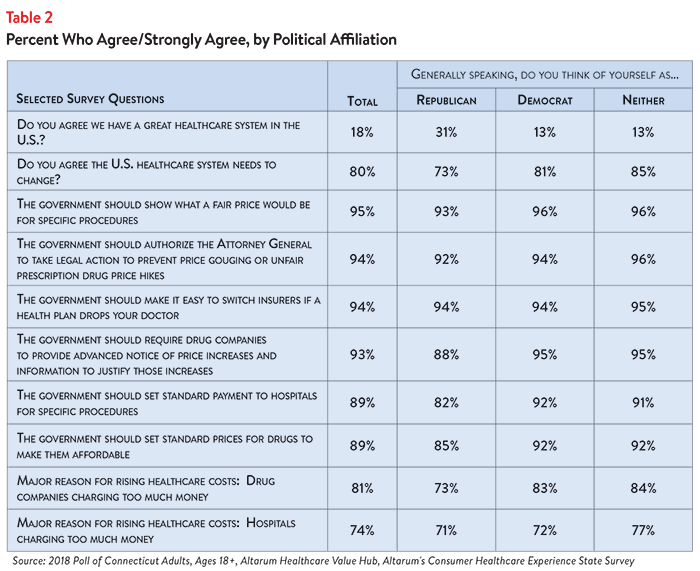
Notes
1.Guzman, Gloria, Household Income: 2016, American Community Survey Briefs, U.S. Census Bureau (September 2017). https://www.census.gov/content/dam/Census/library/publications/2017/acs/acsbr16-02.pdf
2.Additional worries are losing health insurance (34%); affording health insurance (61%); affording nursing home or home care (67%).
3.Guzman (September 2017).
Methodology
Altarum’s Consumer Healthcare Experience State Survey (CHESS) is designed to elicit respondents’ unbiased views on a wide range of health system issues, including confidence using the health system, financial burden and views on fixes that might be needed.
The survey used a web panel from SSI Research Now with a demographically balanced sample of approximately 1,000 respondents who live in Connecticut. The survey was conducted only in English and restricted to adults ages 18 and older. Respondents who finished the survey in less than half the median time were excluded from the final sample, leaving 926 cases for analysis. After those exclusions, the demographic composition of respondents can be found in the table below. Additional information on the survey instrument is available upon request by emailing hubinfo@altarum.org.
